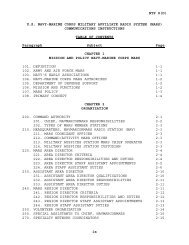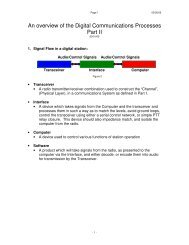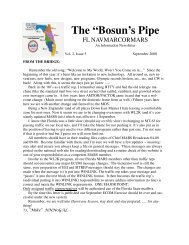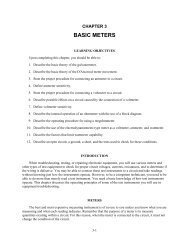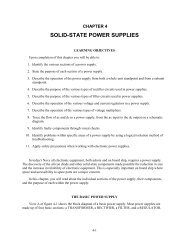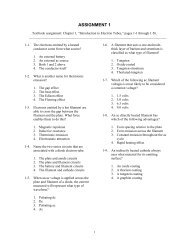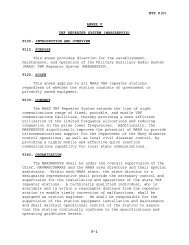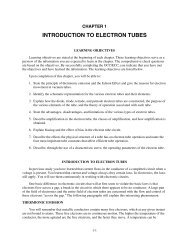NEETS Module 8, Chapter 1
NEETS Module 8, Chapter 1
NEETS Module 8, Chapter 1
Create successful ePaper yourself
Turn your PDF publications into a flip-book with our unique Google optimized e-Paper software.
AMPLIFIER FEEDBACKPerhaps you have been around a public address system when a squeal or high-pitched noise hascome from the speaker. Someone will turn down the volume and the noise will stop. That noise is anindication that the amplifier (at least one stage of amplification) has begun oscillating. Oscillation iscovered in detail in <strong>NEETS</strong> <strong>Module</strong> 9, Introduction to Wave-Generation and Wave-Shaping Circuits. Fornow, you need only realize that the oscillation is caused by a small part of the signal from the amplifieroutput being sent back to the input of the amplifier. This signal is amplified and again sent back to theinput where it is amplified again. This process continues and the result is a loud noise out of the speaker.The process of sending part of the output signal of an amplifier back to the input of the amplifier is calledFEEDBACK.There are two types of feedback in amplifiers. They are POSITIVE FEEDBACK, also calledREGENERATIVE FEEDBACK, and NEGATIVE FEEDBACK, also called DEGENERATIVEFEEDBACK. The difference between these two types is whether the feedback signal is in phase or out ofphase with the input signal.Positive feedback occurs when the feedback signal is in phase with the input signal. Figure 1-15shows a block diagram of an amplifier with positive feedback. Notice that the feedback signal is in phasewith the input signal. This means that the feedback signal will add to or "regenerate" the input signal. Theresult is a larger amplitude output signal than would occur without the feedback. This type of feedback iswhat causes the public address system to squeal as described above.FEEDBACKSIGNALFEED-BACKNETWORKINPUT SIGNALOUTPUT SIGNALNTS080115Figure 1-15.—Positive feedback in an amplifier.Figure 1-16 is a block diagram of an amplifier with negative feedback. In this case, the feedbacksignal is out of phase with the input signal. This means that the feedback signal will subtract from or"degenerate" the input signal. This results in a lower amplitude output signal than would occur withoutthe feedback.1-18





